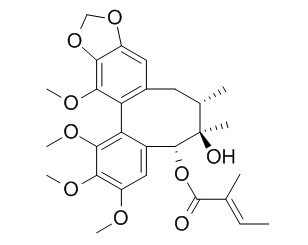Tigloylgomisin P
Tigloylgomisin P shows moderate to marginal cytotoxicity against A549, PC-3, KB and KBvin human cancer cell lines.
Inquire / Order:
manager@chemfaces.com
Technical Inquiries:
service@chemfaces.com
Tel:
+86-27-84237783
Fax:
+86-27-84254680
Address:
1 Building, No. 83, CheCheng Rd., Wuhan Economic and Technological Development Zone, Wuhan, Hubei 430056, PRC
Providing storage is as stated on the product vial and the vial is kept tightly sealed, the product can be stored for up to
24 months(2-8C).
Wherever possible, you should prepare and use solutions on the same day. However, if you need to make up stock solutions in advance, we recommend that you store the solution as aliquots in tightly sealed vials at -20C. Generally, these will be useable for up to two weeks. Before use, and prior to opening the vial we recommend that you allow your product to equilibrate to room temperature for at least 1 hour.
Need more advice on solubility, usage and handling? Please email to: service@chemfaces.com
The packaging of the product may have turned upside down during transportation, resulting in the natural compounds adhering to the neck or cap of the vial. take the vial out of its packaging and gently shake to let the compounds fall to the bottom of the vial. for liquid products, centrifuge at 200-500 RPM to gather the liquid at the bottom of the vial. try to avoid loss or contamination during handling.
Bull. Natl. Mus. Nat. Sci.2021, 47(2),109-114.
Agronomy2022, 12(10), 2426.
Nat Commun.2019, 10(1):2745
J Food Biochem.2019, 43(9):e12970
University of Stuttgart2021, 11682.
Fitoterapia.2021, 153:104995.
Environ Toxicol.2023, 38(7):1641-1650.
Curr Issues Mol Biol.2023, 45(2):1587-1600.
Molecules. 2013, 18(7):7376-88
Plant Physiol.2023, 193(3):1758-1771.
Related and Featured Products
J Nat Prod. 2006 Dec;69(12):1697-701.
Rubrisandrins A and B, lignans and related anti-HIV compounds from Schisandra rubriflora.[Pubmed:
17190445]
METHODS AND RESULTS:
Bioactivity-directed fractionation of an ethanolic extract of the fruits of Schisandra rubriflora led to the isolation and identification of dibenzocyclooctadiene lignans including the new lignans rubrisandrins A (1a + 1b) and B (2) and the known lignans gomisin J (3), (+/-)-gomisin M1 (4), (+)-gomisin M2 (5), schisanhenol (6), deoxyschisandrin, schisantherin B, schisandrin, Tigloylgomisin P, gomisin O, angeloylgomisin P, and epigomisin O. Their structure and stereochemistry were determined by spectroscopic methods, including 2D-NMR techniques.
CONCLUSIONS:
Compounds 1 and 3-6 were active as anti-HIV agents. (+/-)-Gomisin M1 (4) exhibited the most potent anti-HIV activity, with EC50 and therapeutic index (TI) values of <0.65 microM and >68, respectively.
Pharm Biol. 2013 Sep;51(9):1204-7.
Cytotoxic and potential anticancer constituents from the stems of Schisandra pubescens.[Pubmed:
23883077 ]
The diethyl ether extract of the stems of Schisandra pubescens Hemsl. et Wils. (Schisandraceae) was found to exhibit cytotoxic activity in vitro. However, investigations of the bioactive constituents of this plant have been very limited.
Elucidation of the cytotoxic constituents of S. pubescens was performed.
METHODS AND RESULTS:
Repeated silica gel column chromatography and preparative TLC were used for the chemical investigation of the diethyl ether extract of S. pubescens stems. All isolates were evaluated for their in vitro cytotoxicity against A549, PC-3, KB and KBvin human cancer cell lines.
Nine known compounds were obtained, including four lignans, epischisandrone (1), Tigloylgomisin P (2), cagayanone (3) and (-)-gomisin L₂ (4), together with five triterpenoids, micranoic acid B (5), lancifodilactone H (6), coccinic acid (7), schisanlactone B (8) and anwuweizonic acid (9). Compounds 2-6 and 8 showed moderate to marginal cytotoxicity, with GI₅₀ values of 11.83-35.65 μM.
CONCLUSIONS:
The isolation of 1-9 from S. pubescens and the cytotoxicities of 3-6 are first reported. Compounds 2-6 and 8 could be the active principles responsible for the anticancer effects of S. pubescens.



